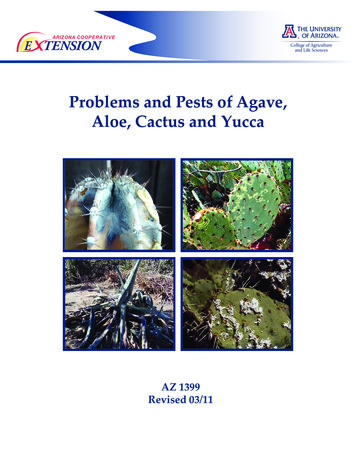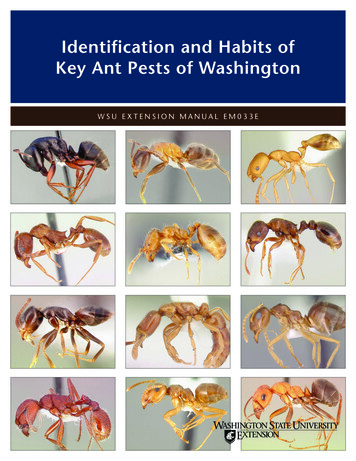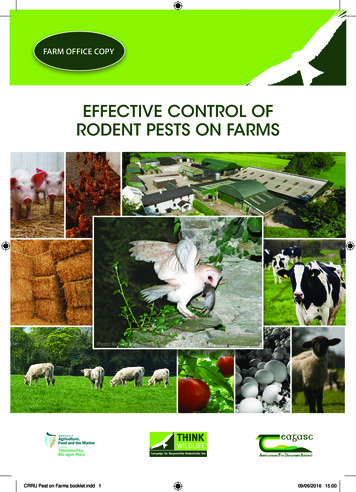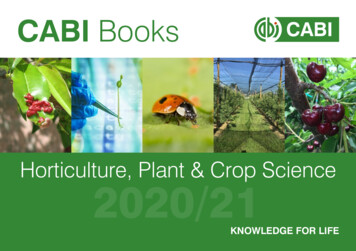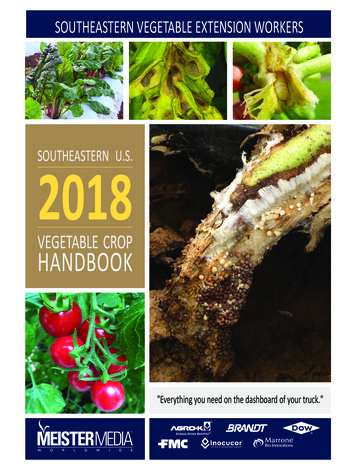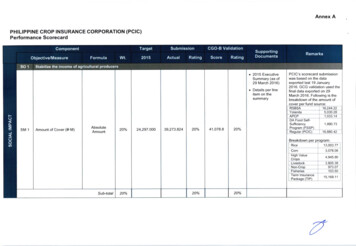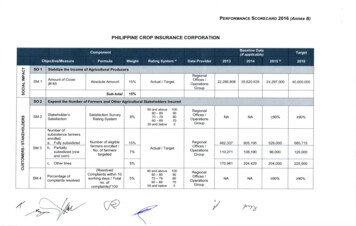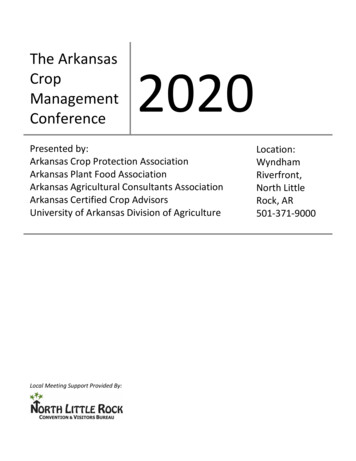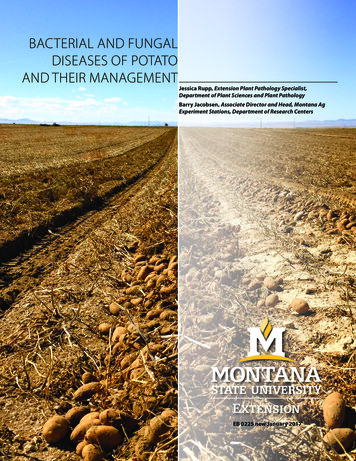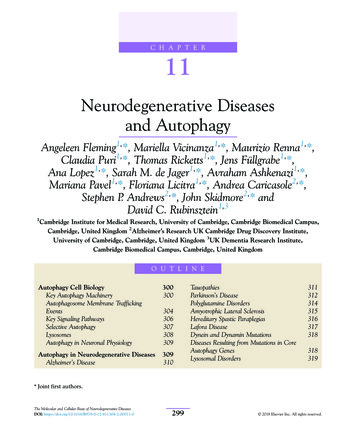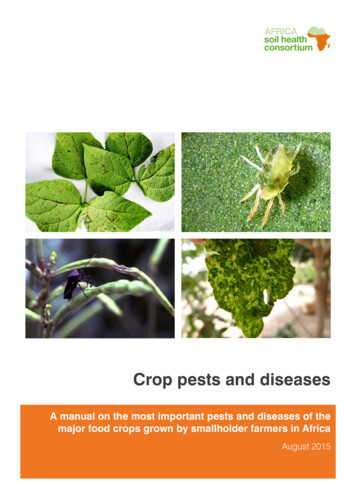
Transcription
Crop pests and diseasesA manual on the most important pests and diseases of themajor food crops grown by smallholder farmers in AfricaAugust 2015
Africa Soil Health Consortium: Crop pests and diseases CAB International 2015Please cite this publication as: Pest and disease manual. Africa Soil Health Consortium, Nairobi, August 2015.This publication is licensed under a Creative Commons Attribution 3.0 Unported License.Creative Commons License:You are free: to share – to copy, distribute and transmit the work to remix – to adapt the work to make commercial use of the workUnder the following conditions: Attribution – You must attribute the work in the manner specified by the author or licensor (but not in any way thatsuggests that they endorse you or your use of the work).With the understanding that: Waiver – Any of the above conditions can be waived if you get permission from the copyright holder. Public Domain – Where the work or any of its elements is in the public domain under applicable law, that status isin no way affected by the license. Other Rights – In no way are any of the following rights affected by the license: Your fair dealing or fair use rights, or other applicable copyright exceptions and limitations; The author’s moral rights; Rights other persons may have either in the work itself or in how the work is used, such as publicity or privacyrights.Notice – For any reuse or distribution, you must make clear to others the license terms of this Limits of liabilityAlthough the authors have used their best efforts to ensure that the contents of this book are correct at the time ofprinting, it is impossible to cover all situations. The information is distributed on an ‘as is’ basis, without warranty.Neither the authors nor the publisher shall be liable for any liability, loss of profit, or other damages caused or allegedto have been caused directly or indirectly by following the guidelines in this book.About the publisherThe Africa Soil Health Consortium (ASHC) mission is to improve the livelihoods of smallholder farmers throughadoption of integrated soil fertility management (ISFM) approaches that optimize fertilizer use efficiency andeffectiveness.ASHC books are available at special discounts for bulk purchases. Special editions, foreign language translations andexcerpts, can also be arranged.ISBN (e-book): 9781780648194ISBN (paperback): 9781780648187Typeset by Sarah Twomey2
AcknowledgementsThe preparation of this manual was supported by the Bill & Melinda Gates Foundation.We would also like to thank:Eric Boa, Erica Chernoh and Grahame Jackson who wrote the pest and disease factsheets this manual is based upon.The many photographers who allowed us to use their excellent photographs. Individual credits and copyright statusare given under each photograph.The Africa Soil Health Consortium delivery team: Keith Sones, Dannie Romney, Victor Clottey, James Watiti, AbigaelMchana and George Oduor.3
Contents1. Introduction. 62. Integrated pest management. 73. Pesticide use and safety. 84. The major pests and diseases of cereals. 10PestsMaize stalk borers. 13Larger grain borer. 15Cotton bollworm. 17Millet stem borer . 19Sorghum midge. 21Sorghum stem borers. 23African rice gall midge. 25DiseasesGrey leaf spot of maize. 27Maize ear rots and mycotoxins. 29Maize lethal necrosis disease. 31Pearl millet downy mildew. 33Rust of pearl millet. 35Sorghum downy mildew. 37Bacterial leaf blight of rice. 39Rice blast. 41Rice yellow mottle disease. 43BirdsRed-billed quelea . 45WeedsStriga or witchweed. 475. The major pests and diseases of legumes. 49PestsBean bruchid . 53Legume pod borer . 55Pod-sucking bugs of cowpea. 57Bean flower thrips. 59Cotton bollworm . 61DiseasesBean anthracnose. 63Bean blight. 65Common mosaic of bean . 67Halo blight of beans. 69Early and late leaf spot of groundnut. 71Stem and pod rot of groundnut. 73Groundnut rosette disease . 75Groundnut rust. 77Anthracnose of cowpea . 79Cercospora leaf spot of cowpea . 81Mosaic diseases of cowpea . 83WeedsStriga or witchweed. 854
6. The major pests and diseases of root and tuber crops. 87PestsCassava green mite. 91Sweet potato weevil. 93Greater and lesser yam beetle. 95Yam moths. 97Cotton bollworm. 99DiseasesPhytoplasma diseases of cassava . 101Cassava brown streak disease . 103Cassava bacterial blight. 105Cassava mosaic disease. 107Leaf petiole and stem blight disease of sweet potato. 109Sweet potato virus disease . 111Yam dieback. 113Dry rot of yam. 115Yam mosaic disease. 117Late blight of Irish potato. 119RodentsRats and mole rats of sweet potato . 1217. The major pests and diseases of bananas. 123PestsBanana weevil . 125DiseasesBlack sigatoka of banana. 127Fusarium wilt of banana. 129Bunchy top of banana . 131Banana xanthomonas wilt. 1335
1. IntroductionThis manual aims to provide clear, actionable information on the most important pests and diseases that affect themajor food crops grown by smallholder farmers in Africa.For each pest or disease, information is provided on how to recognise the problem, what to do to prevent it occurringand how to control it when it occurs. The management options for each pest or disease are divided into ‘culturalapproaches’, such as use of resistant varieties, clean seed, crop rotations and good hygiene in the field, and‘chemical approaches’, which involve the use of appropriate pesticides. In addition information is provided on theorganism that causes the problem and its impact. Finally, a short list of publications and websites is given whereadditional information can be obtained.A team of plant health experts has compiled this information; in doing so they have drawn upon the latest researchand information available in 2015.This manual is targeted at extension workers and anyone else who needs access to clear, actionable information onthe most important pests and diseases affecting the major food crops grown by smallholders.Crops covered are: cereals (maize, millet, sorghum, rice), legumes (groundnuts, beans and cowpeas) roots andtubers (cassava, sweet potato, yam) and banana.This manual is an output of the African Soil Health Consortium (ASHC), a project managed by CABI. Funding for themanual was provided by the Bill & Melinda Gates Foundation.6
2. Integrated pest management2.1 What is IPM?For each pest and disease covered in this manual, methods are first given for prevention of the problem. Then, ifintervention is needed when a pest or disease occurs, the safest and most effective options available are listed.The approach used in the manual is called Integrated Pest Management (IPM).IPM consists of 4 main steps:1. Identification: The section on Key Signs is designed to help identify the pest or disease. 2. Prevention: This includes cultural approaches, such as use of disease resistant varieties, disease-free seed andadoption of good practices in the field, such as removal of infected material that could carry the problem over tothe next crop. It also includes use of pesticides where this method is appropriate. 3. Monitoring: The earlier a pest or disease is noticed, the earlier appropriate action can be taken to reduce lossesand prevent its spread. 4. Control: This includes both cultural approaches, such as removal of infected plants, as well as use of appropriatepesticides.IPM often involves the combination of several different options. Pesticides tend to be used when other approaches areinadequate for the problem at hand; they must always be used in accordance with the usage and safety informationgiven on the pack.2.2 Monitoring crops for pests and diseasesWith most pests and diseases, the earlier the problem is noticed the better: it will be easier to take action tohelp prevent severe losses occurring or stop the pest or disease spreading throughout the crop and beyond toneighbouring fields.The best way of achieving this is to regularly and systematically inspect the crop. One way to do this is to walk throughthe field or plot following an M-shaped pattern; this will ensure the farmer doesn’t just look around the edges but alsolooks in the middle.If any problems are noticed, the farmer should carefully examine the plants for signs of the problem and clues as tothe cause:Signs on the crop might include: Has the plant wilted – that is has the plant become less rigid than normal and is drooping? Are the leaves more yellow than usual? Have the leaves changed from green to some colour other than yellow? Are the plants smaller than usual? Have parts of the plant died? Are there unusual streak patterns on the leaves or stems? Do the leaves have spots on them? Are the leaves chewed – are there holes in them that look as though they have been eaten? Are there signs of the animals that might have done this? Are the leaves blistered or wrinkled? Are the leaves or fruits an unusual shape? Are the leaves smaller than usual and/or bunched closer together than usual? Do the leaves have patterns of lighter green and yellow giving a mottled or patchwork effect? Are there brown marks on the edges of the leaves? Is there an unusual growth on the surface of the leaves or other parts of the crop? Are there holes in the stem or grain? Are there lumps or swellings on the leaves or other parts of the plant? Are parts of the plant rotting – that is, becoming soft and slimy?If any of these signs are seen the farmer should be encouraged to seek help from an extension worker, knowledgeablelocal farmer or staff at the local agro-dealer or research station.7
3. Pesticide use and safety3.1 What are pesticides?Pesticides are mostly chemicals although some are biological agents, such as special types of fungi, that deter, weaken,kill, or otherwise discourage pests. They are commonly used worldwide to control a wide range of pests in agriculture.Pests can be insects, rodents, birds and other animals, weeds, fungi, or microorganisms such as bacteria and virusesthat have a detrimental impact on crops. Some kill the plants, others weaken them or reduce the yield in some way,while others attack the crop after harvest while it is being stored prior to use.Some pests cause direct damage, such as quelea birds which feed on millet crops; other pests do not cause damagedirectly but can carry harmful micro-organisms such as fungi, bacteria or viruses. Fungi, bacteria and viruses cancause various diseases; for example: several species of aphid spread the virus that causes yam mosaic virus disease.This manual includes pest and disease management options based on pesticides.3.2 Safety and efficacyPesticides are considered to be easy to use and effective; however, pesticides are often misused and can cause humanhealth effects and environmental contamination.Furthermore, repeatedly using pesticides with the same mode of action (or method for controlling a pest) can lead to buildup of resistance, making the pesticides less effective. Where appropriate, recommendations are provided in this manual toavoid this problem.Many countries have problems with counterfeit pesticide products being sold and used. These co
3. Monitoring: The earlier a pest or disease is noticed, the earlier appropriate action can be taken to reduce losses and prevent its spread. 4. Control: This includes both cultural approaches, such as removal of infected plants, as well as use of appropriate pesticides. IPM
